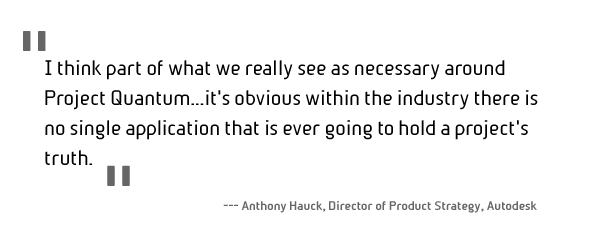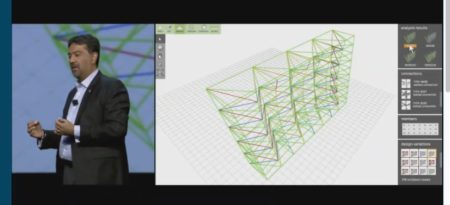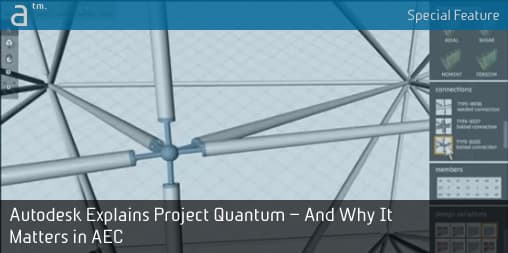Autodesk is on a mission in AEC software. Late last year at its annual Autodesk University conference, the company gave its first public glimpse of its rumored “Project Quantum”—its futuristic vision of the way software wants to work in the AEC industry.
Since that time there really hasn’t been much definitive information truly written about it. And there are lots of mysteries and questions. And the company knows this, which is why it’s a major agenda item on its annual AEC Media Summit, being held this week in Boston.
So it’s a fortuitous break that Architosh got a chance to sit down with Autodesk a few weeks ago to discuss Project Quantum in full detail.
I’m at Autodesk’s sleek new offices in Boston in the Fort Point Channel district. To my left is Anthony Hauck, Director of Product Strategy and Jim Lynch, Vice President, AEC Products, both of Autodesk. Jim has promised to pretty much answer any question I have about Quantum. Nothing is off the table. Well, almost nothing.
A Ground-Up ReThink
I started the conversation by asking if they could tell me in a nutshell why Project Quantum even exists. Jim Lynch didn’t hesitate to respond. “In a nutshell what we are trying to do with Quantum is really rethink the whole idea of multi-disciplinary coordination and collaboration.”
This is the area of AEC where the greatest friction exists around legacy analog processes converted to their digital transformation. “I think part of what we really see as necessary around Project Quantum,” adds Anthony Hauck, “it’s obvious within the industry there is no single application that is ever going to hold a project’s truth.”
At this point, Lynch puts up a slide from Quantum’s deck showing a large complex project from China and the incredible array of software applications, the players using them, and the way data must pass back and forth between all of these digital tools. “When you think about multi-disciplinary design this really sums it up,” says Lynch.

Autodesk is well aware that it is common for large AEC projects to feature more than 100 or even 200 software applications in their total creation. This involves the tools the architect uses all the way to the tools the actual building products and fabricators use, from the guys that build the curtain walls to the folks making special light fixtures, gaskets, doors, one-off structural elements, shading elements, etc., you name it.
“I’ve talked to customers for years,” adds Lynch, “and you get that 10-point process diagram…and you learn there are 250 applications involved in there. And we—[Autodesk]—on the outside may have eight of them, sometimes four.”
Building A Better Glue
The argument that Hauck and Lynch are laying out for me is clearly centered on the age-old problem of AEC interoperability between software systems. This is nothing new. What feels very different though is the way the company is talking about it.
“So there is this whole ecosystem of applications [out there] that are all trying to work together,” says Hauck, “and largely the glue holding all that together is a bunch of people doing a bunch of operations. We think there are ways not only to make that better but perhaps automate it.”
I asked why Revit couldn’t provide this better interoperability or why Revit can’t do what Project Quantum is attempting to do. Lynch says flatly, it could if everyone was using it. But that clearly isn’t quite the whole story. What Project Quantum will do better than Revit—amongst many things—is be a superior broker moving the data between so many data silos.
Lynch adds, “Our customers tell us they are either receiving too much information or they are not getting the right information at all. And so, if we can help broker that information between the design team and the fabricator, perhaps we can make it more meaningful and insightful.”
In other words, they don’t need the entire Revit model to get what they want. But that is what is largely happening in the industry today. “In the collaboration model that is Project Quantum I get what I need and I don’t need to sift through a lot of information to get to what I’m trying to do,” adds Hauck.
The Essence is Transportable
So far what the three of us have been talking about is how different AEC players are overloaded with geometry data (both 2D and 3D) in addition to the common struggle to get to precisely the data, they need. Hauck and Lynch say Autodesk refers to this as “noise” in the process of moving data around environments.
Hauck goes on to describe a finite element analysis (FEA) structural engineering process with a building, a process whereby the software systems analyze forces in three dimensions but do not require all the details of the actual building elements.

01 – Amar Hanspal of Autodesk showing the audience Project Quantum at 2016 AU. Architosh has seen several working examples of Project Quantum at Autodesk’s Boston offices.
“In that analysis, the structural decisions can really just be coming down to say a curve with some characteristics,” says Hauck, “you don’t need the more elaborate manifestation of how the structural members are coming together, as say you would in a detailing environment. So you don’t need to move that detail around everywhere [across applications] you just need that detail where you need it.”
“That’s an easy one to describe and there are a whole bunch of more elaborate relationships,” adds Hauck, ‘but essentially there is an essence of intent around design and engineering that we believe is transportable around multiple environments for elaboration.”
In other words, Autodesk’s Project Quantum will enable interoperability workflows, between AEC players, which can just zero in on the transportability of “design intent” or engineering intent in ways that provide granularity based on the specific set of tools involved in the Quantum interface.
Quantum Is Really A Platform
But what exactly is Project Quantum?
I’m asking Jim Lynch to give me the “brass tacks” version. And I give Lynch and Hauck several mythologies about Quantum out in the blogosphere—of which they laugh and then transition to clarify.
So here is what Quantum is not. Project Quantum is not a Revit killer. The new thing is not going to eat the old thing. At least not overnight. And Project Quantum is not “Revit for the Cloud” as Lynch emphatically clarifies. But it should be understood that Quantum is all about the cloud as “platform” and that part—people should understand.
I make an analogy some of my peers in the press have made. Lynch responds: “What is not true is that this is the Revit of manufacturing. As Inventor is to Fusion some people are suggesting Revit is to Quantum.”
02 – This video hosted by Architosh’s Vimeo channel shows a demo of Autodesk Project Quantum. This video was given to Architosh exclusively for this story. All rights reserved.
“What is true,” Lynch continues, “is we are using some technology that we either built or acquired on the manufacturing side.” But he continues, where Fusion is really a design tool, Quantum is really about collaboration and coordination.
As for that manufacturing tech that is partly inside Quantum? These are details that went beyond our conversation. However, it is probably safe to say that Quantum and Fusion share some digital DNA.
next page: No Revit for the Cloud. No Revit for Mac




Reader Comments
We look forward to reading more reports on Quantum from other fellow writers at this week’s Autodesk AEC Media Summit. We’ll be sure to comment on things we feel are of note to readers. The industry is likely to have a variety of views about what Quantum may mean for Autodesk customers and the world of BIM/AEC in general.
We look forward to reading more reports on Quantum from other fellow writers at this week’s Autodesk AEC Media Summit. We’ll be sure to comment on things we feel are of note to readers. The industry is likely to have a variety of views about what Quantum may mean for Autodesk customers and the world of BIM/AEC in general.
[…] découvrir sur Architosh, un article d’Anthony Frausto-Robledo AIA, LEED AP, architecte américain et journaliste sur Architosh qui a eu la chance de rencontrer Anthony Hauck, […]
[…] of projects from their development on our Forge platform to R&D efforts with Autodesk’s Project Quantum. Look out for more news on Project Quantum and from FenestraPro next week at Autodesk University. […]
Comments are closed.